Chapter: 11th Home Science : Chapter 5 : Nutrition
Fat Soluble Vitamins: Functions, Food sources, Deficiency
Vitamins
Fat soluble vitamins A, D, E and K and also water-soluble vitamins C and B group are found in foods. These are needed for growth, normal function of the body and normal body processes.
Fat Soluble Vitamins
(a) Vitamin A:
The vitamin A compounds include retinol, retinal and retinoic acid. Because it has a specific function in the retina of the eye and because it is an alcohol it was given the name ret-inol. Beta carotene is precursor of vita-min A and is found in large quantities in vegetables and fruits.
Functions: Vitamin A performs the following functions:
· Vitamin A is essential for vision in normal and dim light.
· Formation and maintenance of healthy functioning epithelial tissue.
· Glycoprotein and mucoprotein synthesis
· Cancer prevention
· Prevention of degeneration of myelin sheath
· Normal bone formation and reproduction.
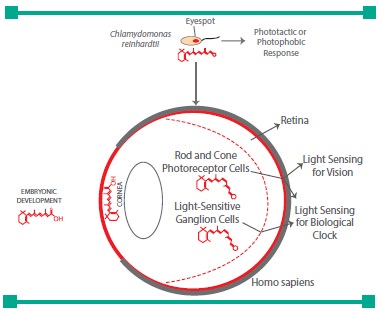
Food sources: In the animal foods vitamin A is present in the form of retinol which are identified to be liver, cream, butter and egg yolk. Liver oils of fish like cod, halibut and shark are the richest sources of vitamin A. The main contribu-tors of beta carotene are the yellow and green vegetable fruit sources of carotene- carrots, papaya, mango, sweet potatoes, spinach and broccoli.
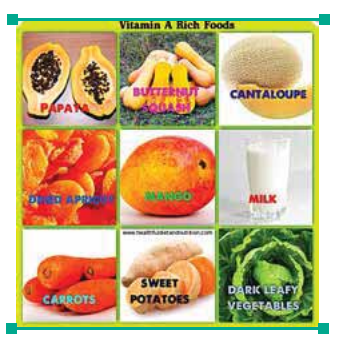
Deficiency: Decreased Vitamin A intake leads to vision problems
· Night blindness: People suffering from night blindness cannot see objects in dim light
· Xerosis Conjunctiva: The conjunctiva is dry, thickened, wrinkled and pigmented. This is due to the keratinization of the epithelial cells.
· Xerosis Cornea: This man ifests in the form of corneal dryness which gives the cornea a dull hazy and lusterless appearance.
· Bitot’s spots: These are grey-ish or glistening white plaques occurring in the conjunctiva usually triangular in shape and are found in children.
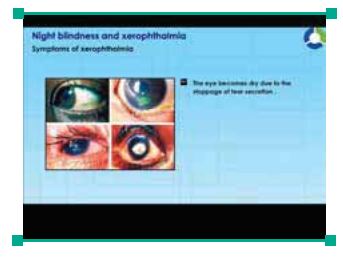
· Keratomalacia: When Xerosis of the conjunctiva and cornea is not treated it may develop into the condition called ker-ato malacia which is character-ized by necrosis, ulceration and bacterial invasion of cornea leading to the total destruction of the eyeball and eventually total blindness.
Prevention of vitamin A deficiency
The strategy should be a combina-tion of long term nutrition educa-tion programme, enhanced intake of vitamin A rich food, improve-ment in household food security and availability of vitamin A rich foods and a periodic massive dose of vitamin A.
(b) Vitamin D:
Vitamin D is known to be a prohormone of a sterol type and the synthesis of active form of vitamin D is known as the 1,25 – dihydroxycho-lecalciferol which is accomplished by the combined action of skin, liver and kidneys.
Functions
· Maintains balance with para-thyroid hormone to stimulate the active transport of calcium and phosphorus.
· Acts on the bones promoting calcification.
· Facilitates the absorption of calcium and phosphorus from the intestines.
Involved in widespread basic cell processes with targets in brain, kidney, liver, skin, repro-ductive tissues.
Food sources: Vitamin D is pres-ent only in some foods of animal origin. Certain marine fishes and fresh water fishes are known to be good sources of vitamin D. The most important sources are egg yolk, butter, cheese, milk.
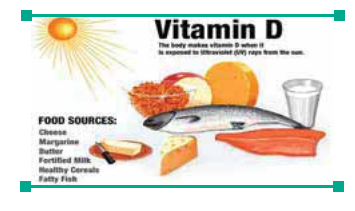
Deficiency: Vitamin D deficiency occurs in children who are not ade-quately exposed to sunlight. It is characterized by inadequate min-eralization of the bone. In children the condition is known as rickets and in adults it is called Osteoma-lacia.
Rickets: In rickets there is soft-ening of the skull bones and the head is enlarged, elongated and flattened on the vertex. Softening of the ribs, sinking of the chest, beaded junctions of the ribs with cartilages (rickety rosary), pigeon chest, knock knees and bow legs. Deformities of the long bones spine, pelvis, muscles, and feet are observed. Dentition is delayed.
Osteomalacia: It is the adult counterpart of rickets. It occurs in
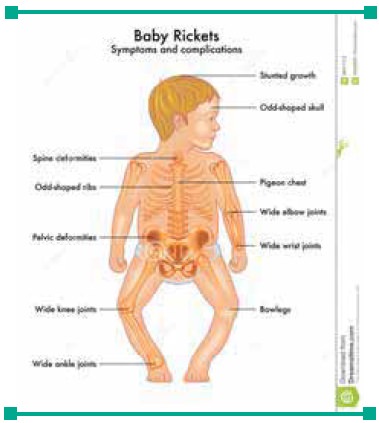
Besides it is found among those who stay indoors all day and seldom go out in the sun.
(c) Vitamin E:
Vitamin E is the generic name for a group of vitamins, three of which –alpha tocopherol, beta tocopherol and gamma tocopherol display the greatest biologic activity. Of these three, alpha tocopherol is the most significant form of Vitamin E
· Functions
· Vitamin E a major antioxidant which reduces the incidence of heart diseases.
· It is essential for normal repro-duction in man.
· It acts along with selenium in reducing the body’s require-ment for each other.
· It plays a vital role in the immune function of the body.
Food sources: Vegetable oils, nuts and whole grams are the richest sources of vitamin E (eg. Wheat germ oil). It is present in small quan-tities in lettuce, grasses and embryos of many seeds. In general, plant foods are richer sources of vitamin E than animal foods.
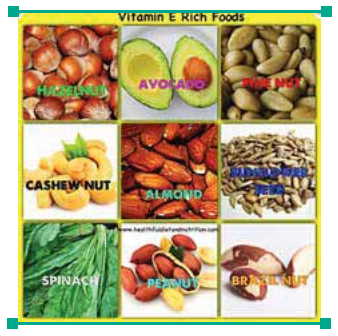
Deficiency: Vitamin E deficiency has been associated with irritabil-ity, edema and hemolytic anemia among infants. Also Muscular dys-trophy is common to all species in which there is degeneration of skel-etal and cardiac muscle with vita-min E deficiency.
(d) Vitamin K
Vitamin K occurs in two forms.
· Phylloquinones (vitamin K1) - plant source and dietary form of vitamin K
Menaquinone (vitamin K2) - syn-thesized by intestinal bacterial flora.
Functions: The major functions of Vitamin K though not many are listed as follows:
· Vitamin K is essential for blood clotting.
· Required for the synthesis of blood clotting factors by the liver.
· Vitamin K is vital to maintain normal levels and activation of blood clotting factor like prothrombin,
Food Sources:
The major dietary source of vita-min K is Phyllo Quinone which is present in high concentration in most vegetables like cabbage, spin-ach and cauliflower. Animal food sources include cheese, egg yolk, and liver.
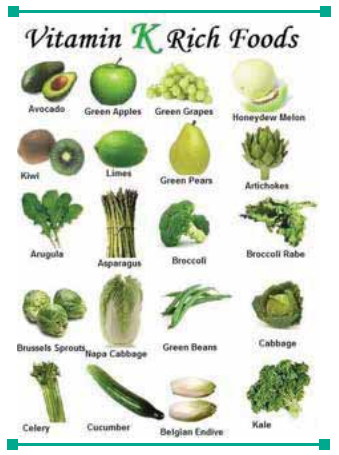
Deficiency: It manifests in the form of defective blood clotting. Low levels of prothrombin and hemor-rhage are seen in severe forms of deficiency.
Related Topics